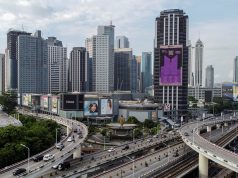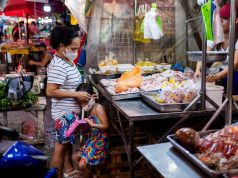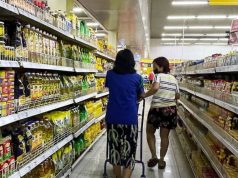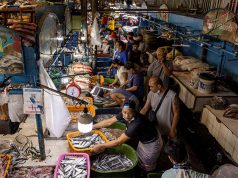MANILA – The Philippine economy grew by 6.4 percent in the first three months of 2017, the Philippine Statistics Authority (PSA) announced on Thursday, with the figure lower than the 7 percent expected by officials and the 6.8 percent from a BusinessWorld poll.
The first-quarter’s 6.4 percent was lower than the GDP growth of 6.6 percent in the fourth quarter of 2016 as well as the recorded 6.9 percent GDP growth in the same period last year.
Speaking at a press briefing, Socioeconomic Planning Secretary Ernesto Pernia conceded, “It is however lower than the desired expected. We are somewhat downcast because we were expecting something around the mid-growth range of 6.5 percent to 7.5 percent.”
Pernia explained that the slower economic growth has been a trend in the years following elections as election spending dissipates.
Nonetheless, the latest figure was better than the first quarter GDP growth rate of previous post-election years: 4.9 percent in 2011 and 5.7 percent in 2014.
Pernia added that the slower GDP growth could be attributed to higher inflation rates.
Despite the lower GDP growth, Pernia said the Philippines remained among the strongest performers among major emerging economies in Asia, overtaking Vietnam’s 5.1 percent and Indonesia’s 5.01 percent. Meanwhile, India has not yet released its economic figures.
The Philippines was second only to China’s 6.9 percent growth, Pernia noted.
Q1’s main drivers, risks to economy
According to PSA, the services sector was the main driver of growth among major economic sectors for the quarter as it grew by 6.8 percent. This was followed by the industry sector, which decelerated to 6.1 percent as compared with the 9.3 percent recorded in the first quarter of 2016.
Meanwhile, the agriculture sector recovered with 4.9 percent growth from a decline of 4.3 percent from the previous year.
From the demand side, main contributors of GDP growth in the first quarter were household consumption as well as investments in durable equipment and construction.
Exports of goods also grew by 22.3 percent, the fastest rate since the third quarter of 2010, Pernia noted.
As for government spending which barely changed at 0.2 percent, the NEDA chief said: “the changing of the guard of the government and reorientation of programs really take time to settle, and this slowed government spending for the quarter.”
Pernia listed as well the possible downside risks to the economy:
• market volatility from continuing United States interest rate normalization
• geopolitical tensions in various regions
• possible rise of protectionist sentiments in Western countries
• El Niño phenomemnon
Despite the slower-than-expected growth, the government is poised to maintain, Pernia said, the economic growth momentum with the recovery of external trade and private sector’s steadfast optimism.
“To sustain the growth momentum of exports, it is important to ease government regulation, strengthen market intelligence gathering with the help of the private sector, and maximize trade agreements and economic groupings, especially with our ASEAN neighbors,” he said.
He said the government is seeing a strong footing in the succeeding quarters, as it focuses on its major infrastructure program as well as other government programs, including investments in human capital, under the Philippine Development Plan.
“It is important to ensure that government spending for both consumption and investment remains within the fiscal program, which is critical to sustain the growth momentum,” he said.
“With the steady unfolding of the Build Build Build program in the coming months, we expect construction activities and public spending to pick up sharply, consistent with the government’s aim to spend 5.3 percent of GDP this year for infrastructure and up to 7.4 percent by 2022,” he added









